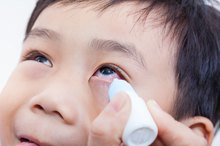Signs & Symptoms of Eye MRSA
Methicillin-resistant Staphylococcus aureus was first discovered in 1961 and is an infectious bacterium that is resistant to some common antibiotics, including methicillin, amoxicillin, penicillin and oxacillin. MRSA is spread by contact with another person with MRSA on their skin or objects contaminated by the bacteria.
If you are experiencing serious medical symptoms, seek emergency treatment immediately.
MRSA infections are most common among hospital patients and the elderly with weak immune systems. Another type of MRSA called community-associated MRSA, or CA-MRSA, has become more common since MRSA was originally discovered. CA-MRSA occurs in non-patients and otherwise healthy people 1.
MRSA can affect different parts of the body, including the skin and eyes. The most common symptom of MRSA of the eye is the formation of a stye along the edge of the eyelid.
Early Symptoms
A stye is an infection that results in a tender red lump along the edge of an eyelid. The bacteria usually grow in the root, or follicle, of an eyelash. The eyelid will become swollen and more painful as the stye grows. The eye may also water 12.
- A stye is an infection that results in a tender red lump along the edge of an eyelid.
- The eyelid will become swollen and more painful as the stye grows.
Later Symptoms
Chlamydia of the Eye Symptoms
Learn More
Later symptoms can include further swelling, discomfort while blinking and an increased sensitivity to light. Styes will commonly have a yellowish spot at the center of the lump that grows as pus expands in the infected area.
Final Symptoms
The stye will swell for a few days before it breaks open and drains. Most styes swell for around three days and heal in about a week.
Related Articles
References
- Medicine Net: MRSA Definition
- WebMD: Stye Information
- General Information | MRSA. Centers for Disease Control and Prevention. Jun 26, 2019.
- What is sepsis? Centers for Disease Control and Prevention. Aug 27, 2019.
- Pneumonia | Pneumonia Symptoms | Signs of Pneumonia. MedlinePlus. Aug 20, 2019.
- Zeller JL, Golub RM. MRSA Infections. Jama. 2011;306(16). doi:10.1001/jama.306.16.1818.
- Rodvold KA, Mcconeghy KW. Methicillin-resistant Staphylococcus aureus therapy: past, present, and future. Clin Infect Dis. 2014;58 Suppl 1:S20-7. doi:10.1093/cid/cit614
- Sai N, Laurent C, Strale H, Denis O, Byl B. Efficacy of the decolonization of methicillin-resistant Staphylococcus aureus carriers in clinical practice. Antimicrob Resist Infect Control. 2015;4:56. doi:10.1186/s13756-015-0096-x
- Anderson DJ. (2019). Methicillin-resistant Staphylococcus aureus (MRSA) in adults: Epidemiology. Sexton DJ, ed. UpToDate. Waltham, MA: UpToDate Inc.
- Centers for Disease Control and Prevention. (2019). Methicillin-resistant Staphylococcus aureus.
- Harris A. (2019). Methicillin-resistant Staphylococcus aureus (MRSA) in adults: Prevention and control. Sexton DJ, ed. UpToDate. Waltham, MA: UpToDate Inc.
- Huang SS et al. Decolonization to Reduce Postdischarge Infection Risk among MRSA Carrier. N Engl J Med. 2019 Feb 14;380(7):638-50. doi:10.1056/NEJMoa1716771
- Miller LG, Kaplan SL. Staphylococcus aureus: a community pathogen. Infectious Disease Clinics of North America. 2009 Mar;23(1):35-52. doi:10.1016/j.idc.2008.10.002
- Septimus EJ, Schweizer ML. Decolonization in Prevention of Health Care-Associated Infections. Clin Microbiol Rev. 2016 Apr;29(2):201-22. doi:10.1128/CMR.00049-15
Writer Bio
Tyler Clark graduated from The University of Puget Sound in 2005 with a B.A. in English. He was an editor at "The Internationalist," a University of Puget Sound publication, and a senior writer for his high school newspaper. Since graduation, Clark has contributed content to professional and personal websites. He has been writing published work for 10 years.








